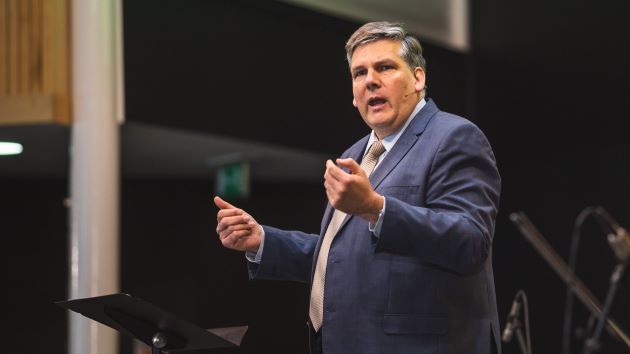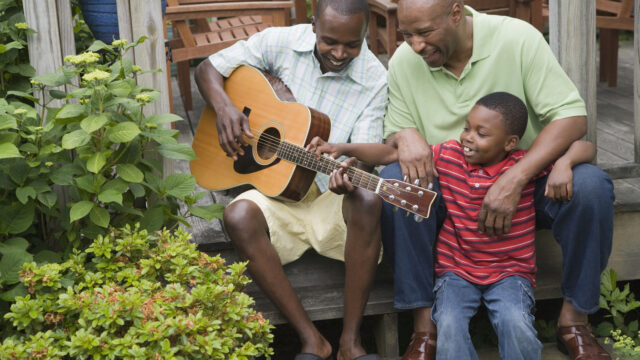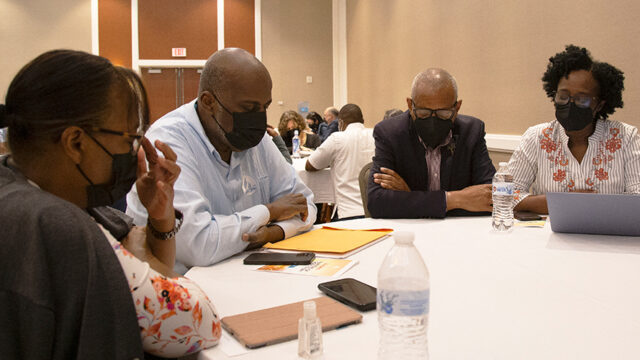Churches rising above the challenges of COVID-19

During the first week of March, I (Willie) was teaching a class in pastoral ministry in California. Although the American states along the coast of the Pacific Ocean comprised the growing epicenter of what would soon be declared a pandemic, none of the approximately 20 of us in that small classroom expressed any longterm concerns. But by the end of the second week in March, elementary, secondary, and postsecondary schools and churches began closing.
Welcome to life in a COVID-19 world, where remote teaching, remote learning, remote worship and Sabbath School, and remote prayer meetings are the norm. Indeed, both academic life and church life were significantly altered. At the first signs of viral spread we continued to assemble, but with the warning that we could not exist in close proximity to each other. No handshakes, no hugs, and no fellowship meals.
Weeks became months, and the impact on worship, fellowship, and mission was felt. We seminary professors had not prepared our soon-to-graduate seminarians for this eventuality. Seasoned pastors were also unprepared for the tsunami striking the shores of our churches.
As the unimaginable year that is 2020 transitions into 2021, we stand convinced that this new normal must be more than a revisiting of the old normal. Rather, it must be a revisioning of a better normal. And this better normal must impact five areas of church life: worship, fellowship, ministry, mission/evangelism, and prayer. According to Acts 2 and 4, these form the core of Christian life. Far from COVID-19 bringing an end to church life as we knew it, it actually serves a greater purpose: leading us into church life as God sees it.
WORSHIP IN THE COVID-19 ERA AND BEYOND
COVID-19 affected people in different ways. Some who were on the fence before became active in worship and ministry. Some seekers became spiritual, taking God very seriously.
A Pew survey¹ found that one third or more of those who had previously attended church regularly do not bother to watch online services. For those whose church affiliation was already tenuous, the disconnect may be permanent.
We found the same to be true in Adventist churches. Of those churches that have opened their doors to in-person services, their attendance is 30 to 60 percent less than their pre-COVID-19 attendance.
Clearly, the way churchgoers are reacting to the pandemic depends in large part on their past experiences and present situation. Some have had a renewal of faith, while others have had a crisis of faith. Many seekers became fully devoted followers of Jesus as they saw how God worked in their lives and the lives of their loved ones. They experienced miraculous healing, seeing the power of God and wanting more of Him. Yet others quietly moved from God because of discouragement, crises of faith, and alienation from church family.
We classify those who drifted from the church into four categories: (1) those who were weak in their faith drifted further from God; (2) people who are afraid to attend for health reasons; (3) people who are discouraged with God because of loss during the crisis, such as the death of a loved one or restrictions they have experienced; (4) those who for convenience might stay home and surf the Internet for spiritual growth.
Churches, as always, need to have a twofold emphasis, discipling believers and evangelizing the world. That is even more so today. If the church wants to be healthy and faithful to its mission, it needs to intentionally do everything it can to bring back its members and assimilate into the life of the church those who are seeking Him.
In writing this article, we reviewed the literature and scouted worldwide for inspiring stories of churches, pastors, and members during and after the shutdown. We discovered that about 10 to 15 percent of churches did little to nothing during the pandemic. On the other hand, about 10 to 15 percent did many things, such as visiting their members, being present on social media, doing Bible studies, and conducting evangelistic meetings. The rest of the churches offered worship services and Sabbath School on Zoom.
We learned many lessons. The more the members did in touching lives and meeting the needs of others, the more the church was able to keep a higher percentage of its members and friends connected to the church. Moreover, tithe and offerings increased, sometimes even higher than prior to the advent of the pandemic. Also, more of their members became active, especially in technology and social media. We also learned that there is no substitute for old-fashioned visitation and touching lives in a personal and authentic way.
Here are several lessons that churches will do well to pay attention to.²
NEW OPPORTUNITIES: MULTIPLE WORSHIP SERVICES
Historically the church has dedicated three or four hours on Sabbath morning for its worship and ministries. The pandemic challenged us to think creatively to come up with other options, new formats, and new places.
Pastors told us that the pandemic created a new revival and spiritual awakening for many people and opportunities to be creative and innovative in communicating the gospel. Many churches had an online attendance far exceeding their church attendance prior to the crisis.
A church in Chicago that had about 150 in attendance before COVID-19 has more than 1,500 people online. Many people are becoming serious seekers of God, finding hope and comfort in Him.
Hyveth Williams, homiletics professor at the Seventh-day Adventist Theological Seminary and pastor of the Grace Place in South Bend, Indiana, told us that since it has gone on Zoom and various digital platforms, its audience has increased dramatically. The Grace Place attendance prior to the pandemic was fewer than 100 people. Today they have about 22,000 people watching the worship services each weekend from almost every continent. “God is doing great things,” says Williams. “He has blessed us richly.”
This happened to many churches regardless of size. Rodney Mills, executive secretary of the Upper Columbia Conference, headquartered in Spokane, Washington, said, “When pastors confessed that their knowledge of technology is very limited, many young people stepped up to the challenge and created many presences for the church on the various social media. Many of those young people who were inactive in the churches are now very active.”
Many churches started livestreaming. But this is the minimum the church can do. We see churches present on all social media all the time. Others are offering worship services at multiple times, such as during Sabbath morning, afternoon, and evening. They also are repeating the cycle on Sunday and other days of the week.
NEW FORMAT: FOCUS ON GOD
The concensus, after speaking with many pastors, is that worship services today must be simple, focused, and shorter. Simple worship is better. Focused and shorter services leave the audience wanting more.
Kevin Smith told us, “We have only a short song service, about five to seven minutes, short children’s story; about five to seven minutes, and a short and focused sermon; about 25 to 35 minutes in length.” Smith continued: “Shorten the sermon and focus it. If you do that, you increase the possibilities of remembering the main points of the sermon.”
Worship is by definition connecting with God and experiencing Him in a personal, intimate way. Worship takes place when our hearts are touched by the heart of God. Therefore, why would we include anything that doesn’t focus on God and the gospel?
Ask of every element of the worship service: “Does this focus on God?” If not, either remove that element or place it toward the beginning of the worship gathering. Such items as announcements, the welcoming of guests, and greeting one another may have a legitimate place, but they should be accomplished in a way that won’t break people’s focus on the Lord and the logical flow of the worship experience.
Streamline elements in the worship experience, thus creating the added benefit of more focused and impactful time spent together. This worship experience should be uplifting, positive, and full of hope. “If there is any time in which people need hope, it is today,” said Moise Ratsara, a pastor in Kalamazoo, Michigan. Organizing a worship committee can help to keep you on track. This committee should include not only musically talented people but people savvy in technology as well.
NEW PLACES: DIFFERENT LOCATIONS
Because of space limitations, churches are finding creative ways to bring their members back to church and attract new ones. Some are converting their parking lot into a drive-in church; others are converting the parking lot into a church that manages to uphold social distancing guidelines; others are using their school playground for a meeting place; others offer multiple services in church buildings to maximize the number of people who come.
There’s no limit to creativity if we are humble and willing to be guided by God and release the creative power of the congregation.
PRAY A LOT
A worship service’s effectiveness does not come from the excellent manner in which the service is conducted, or the talents of the worship leaders, or the effectiveness of the sermons. It comes from the conviction of the Holy Spirit. The power of the Spirit convicts hearts and changes lives.
We discovered from research, observation, and interviews that churches where God is worshipped and glorified, and people are changed and transformed, are churches that pray a lot. They pray before, during, and after worship services. Pastors, leaders, and members take time before Sabbath School and worship to pray over every one of the pews for everyone who comes to church, asking God to show up and do something amazing in their midst. To improve your worship service, pray a lot.
FELLOWSHIP DURING COVID-19
In February 2020 the church I (Willie) attend added a second worship service, which was preceded by a 30-minute interlude dedicated to fellowship. During that half hour those who had just finished Sabbath School could meet with those who were arriving for the second service and enjoy fruit juices, hot beverages (February in Michigan is still cold), fruit, and bite-sized pastries. Tasty treats notwithstanding, the highlight of the time spent in the dining facility was the koinonia, the fellowship, the getting-to-know-you opportunities afforded—especially for visiting with guests and community friends.
After March 7 it all came to a sudden and unexpected halt. Far from seeing this new reality as permanent, we now had to engage in revisioning the concept of koinonia (fellowship). In doing so, we were forced to reexamine our theology of the church in an effort to redefine the meaning of church. And it’s not just our church. Looking at the concept of church may be the best thing to happen to congregations in a long time.
In the short term, churches resorted to Zoom technology. Pastors and others quickly discovered the versatility offered through this platform. Its breakout rooms allow anywhere from one-on-one engagement to larger-group interaction.
Its shortcomings, however, were evident as well. Participants could retain relative anonymity by turning off their video. So prior to March 2020 a person could avoid fellowship simply by making a conscious decision not to attend congregational events, be they worship, prayer meeting, or social activities. Post-March 2020, parishioners can treat church events as they would a buffet: entering in and out of church life (theirs or others), sampling what they want—while minimizing visual or auditory contact. They can enter into the world of other participants while exercising autonomy in determining their own exposure.
COVID-19 has positioned today’s church to innovate as it relates to creating an environment for fellowship, to provide unique avenues for face-to-face communion that affirms God’s church, His body of believers.
The church is uniquely positioned to minister to people as never before. Being locked down for months created a yearning and desire to connect with others. Christians can be instruments to alleviate the loneliness and isolation of others. The Sabbath School class that I (Joseph) attend went online in early March; soon people from outside our church began joining us. They found us on the Internet. They were lonely, and our small group brought God’s presence and love to them.
Early Christians clearly emphasized the importance of fellowship (Acts 2:42).
The New Testament concept of koinonia expresses the idea of being together for mutual benefit. “Let us consider one another in order to stir up love and good works, not forsaking the assembling of ourselves together, as is the manner of some, but exhorting one another, and so much the more as you see the Day approaching” (Heb. 10:24, 25).
Countless individuals have shared with us during the past several months that they realize that just because the church doors have been closed for health reasons, that doesn’t mean the church has closed. Intellectually they realized that the church isn’t a building. But now they practically realize that the church is a community committed to worship and fellowship. Creativity brings them closer to one another as they anticipate a brighter future.
The churches we attend represent countless others worldwide that have engaged in unique ways to celebrate biblical communion. In our bulletins we recognize birthdays and wedding anniversaries for the week or month; but bulletins don’t exist in many churches during a pandemic. Technology bridges the gap, as churches turn to text alerts and voice messages to share the latest announcements. The same works during graduation season. How excited are young people to know that the pastor and others remember them during their special moments.
Many churches have discovered new ways to express the biblical concept of fellowship, koinonia: church members gather to caravan by the home of someone celebrating a birthday, graduating from high school, or those who depend on Sabbath worship service and a meal for fellowship to assuage their loneliness. On a few occasions we have even had drive-by bridal showers in the church parking lot, where physical distancing was maintained and designated individuals collected gifts from those who drove through, placing them on tables. My (Willie’s) daughter and her husband, who married in May 2020, were surprised with an impromptu parking lot reception, complete with honking horns upon their exiting the building. Many of them were members from the church we attended years ago.
The novel coronavirus has accomplished for many what was deemed impossible by some. It has shown us the true definition of church, of fellowship. Fellowship need not take place exclusively in a church building or in someone’s home. Fellowship is a lifestyle that affirms each individual and strengthens the participating body, creating a lifetime of memories and the bonding of saints to one another.
BEGINNING AGAIN
The fear that existed in the minds of many was that worship and fellowship would grind to a halt as a result of COVID-19. These examples prove quite the opposite, as every challenge provides opportunities to revisit how we approach church life. Not only have pastors and other leaders discovered fresh ways to reinvent how they deliver Sabbath School, prayer meeting, youth programming, etc.—they have realized growth in attendance to degrees they never imagined, expanding the reach of their ministries.
May the same be said of your church as well.

Enhancing Fellowship in the Wake of COVID-19
- Use e-mails, text messages, and e-newsletters more than normal to communicate the life of the church, emphasizing that the congregation is still family and that the church will always be more than a building.
- Create excuses to have drive-by events. Celebrate birthdays, anniversaries, graduations, bridals showers, etc.
- Maximize Zoom and its breakout rooms for creative ways to experience social interaction. Don’t limit Zoom to Sabbath School, divine worship, prayer meeting, and board and business meetings.
- Make Zoom and other interactive platforms your colleague in koinonia, thus replacing the novel coronavirus with something else novel that proves attractive for members young and old alike.

- Every worship experience should be positive. People should leave feeling hopeful and inspired.
- Intentionally educate your congregation about how to worship and why we worship.
- Keep the children’s story about five minutes long. Make sure the presenter has enthusiasm and can relate to kids.
- Ask for feedback on a regular basis from the members and leadership team. This will help define the areas in the service that are beneficial and those that still need to be worked on.
- Practice all elements of the worship service, not just the music. Ellen White wrote: “[Worship leaders] should devote some time to practice, that they may employ this talent to the glory of God.”* It is by mindful practice that we are able to hone our God-given talents for the purpose of giving glory to Him.

What’s Needed?
Effective post-COVID-19 ministry does not necessarily need high-tech equipment to reach members. Here are some suggestions to connect digitally with members during a pandemic on a low budget:
- Churches all around the world have used smartphones to livestream worship services, music concerts, weddings, funerals, and more. Livestreaming on YouTube and Facebook is relatively easy to set up.
- Few churches have a budget for expensive HD or 4K cameras, but low-cost alternatives beyond a smartphone camera are becoming more and more available, offering good quality.
- Invite your teenagers and young adults to help set up a viable communication strategy for your church in your particular context. This will also help them find their vital role in your congregation.
- Establish group chats on free social communication apps, such as Google Hangouts, WhatsApp, Facebook, etc. Many members are already familiar with these tools.
- Don’t forget those members who don’t own a smartphone, computer, or tablet.
¹ www.pewforum.org/2020/08/07/attending-and-watching-religious-services-in-the-age-of-the-coronavirus/, accessed September 8, 2020.
² We do not deal with what churches need to do to increase the safety of their members and visitors. This information is available through the local, county, and state health departments.








